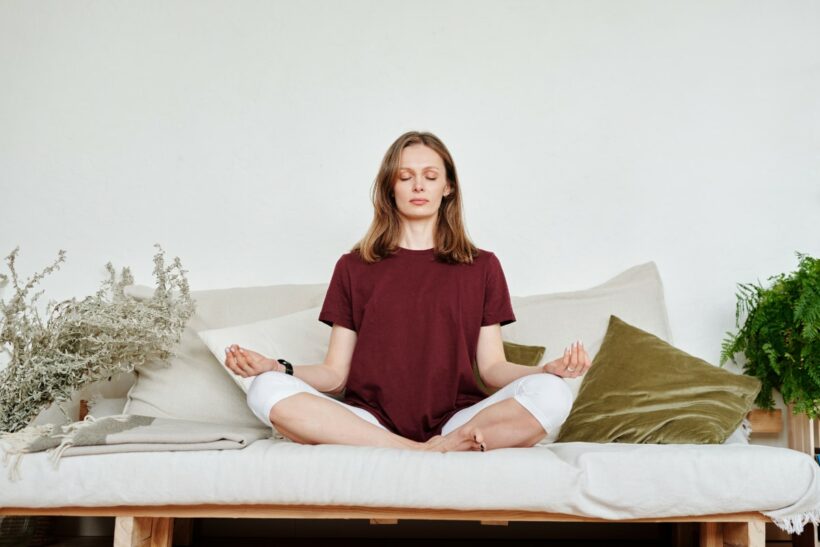6 Meditation Tips and Techniques for Beginners
Beginning a meditation practice seems simple, but if you’ve ever tried adding a meditation habit to your routine you know that it can be challenging. Meditation is more than just sitting quietly and to really experience the benefits it needs to be a part of your daily routine. While starting a meditation practice seems easy enough, there are common stumbling blocks that trip up beignners.
These meditation tips and techniques will help you start and build upon a successful meditation practice.
1. Let Go of Your Expectations
When you imagine meditating your mind may conjure the image of someone sitting in full lotus on a mountain top for hours of peaceful meditation. No one’s practice starts that way and if you hold those expectations at the beginning of your mindfulness practice you will fail to meet them.
Let go of any preconceived notions. Come to meditation with an open mind. Understand that it will be a challenge but you’ll start where you are and over time your practice will deepen and expand.
2. Start Small
Find a quiet place and set aside some uninterrupted time. Pick an achievable amount of time: 60 seconds, 5 minutes, 10 minutes. Set a timer (if you’re using your phone, make sure to put it on “Do Not Disturb”).
You don’t need a fancy meditation cushion or seiza bench. Sit comfortably in a chair or cross legged on the floor.
Close your eyes and focus on your breath. Follow each inhale and exhale with your mind. If you become distracted, just acknowledge the thought, let it go, and return to your breath.
3. Use Guided Meditations or Apps
Guided meditations are an incredible tool for meditation beginners, especially those with anxious minds. Following the verbal prompts can help you keep your mind from wandering and focus on specific goals like relieving stress or falling asleep. I’ve often found that listening to a guided meditation helps me meditate longer. Many guided meditations are available online for free.
Meditation apps are often looked down on by traditionalists but they can be a great way to build a meditation practice. Many offer programs for beginners with daily meditations to lengthen and deepen each session. They also often have reminders and notifications to meditate each day, which can be helpful for building your daily habit.
4. Set Aside a Consistent Time Every Day
To really experience the benefits of meditation and mindfulness you need to practice every day. The common recommendation is to meditate first thing in the morning. It helps create a positive mindset for your day and makes it easier not to forget.
To be successful, you should pick a time that works best for you that you can consistently uphold day to day. If your kids or cats wake you up at inconsistent times then mornings might not work. Maybe taking time to meditate right after you get home from work helps you shed the stress of the day. If you struggle with insomnia, meditation before bed may help you quiet your mind for better rest.
Pick your time and be consistent. It’s okay if you miss a day here or there but aim to take even a short period of time each day for meditation. Over time your mind and body will crave the opportunity to sit and breathe.
If you have to, schedule it into your calendar or set a phone reminder or alarm for your meditation time.
5. Create a Meditation Space
I left this for tip number five because it’s easy to get distracted by material things or trying to make everything perfect before you begin–especially for me. As you add more days experience to your meditation journey, you can create a space that supports your practice.
Whether you can dedicate an entire room or just a corner, pick somewhere in your home that you can consistently use as a quiet and undisturbed place to meditate. Add a few items that help build a ritual that signals to your body and mind that it’s time to meditate. Maybe you wrap yourself in a shawl or light a candle.
Create a space that is relaxing and distraction free, where you can set aside everything else that’s going on in your day and really focus on mindfulness.
6. Make Yourself Comfortable
As you lengthen the time you spend meditating, you may notice that physical discomforts can be a huge distraction. They can also limit the amount of time you meditate. Once you identify these discomforts you can take steps to eliminate them.
A temperature that is too hot or cold can be hard to ignore. Use a shawl or a blanket if you tend to be chilly during meditation–common in the mornings or evenings. If heat is getting to you, trying shedding layers of clothes or turn on a gentle fan.
Pain and discomfort in the body is very common during meditations where you are sitting unmoving for long periods of time. While your body can get used to certain discomforts others may require support through props. First, learn how to sit for meditation and try a few different sitting poses to see what is most comfortable.
If you’re sitting on a hard floor, often adding a blanket or cushion can provide extra comfort. If that’s not enough, zafu and zabuton meditation cushions or a meditation chair can add cushion while also promoting proper posture to avoid back pain.
If the floor is not comfortable for you, there is no shame in sitting on a chair or even laying down for meditation. Find what best supports your body.
Find more tips in How to Start a Meditation Practice.

Looking for more ways to support your meditation practice?
Meditation Books for Beginners
Meditation DVDs and Videos for Beginners
